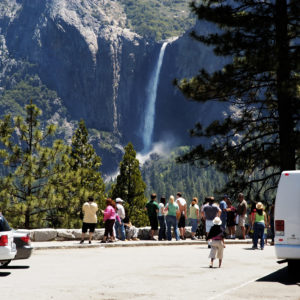Editor’s Note: For an alternative viewpoint, please see: Counterpoint: Some National Park Limits Are Needed
This year the National Park Service celebrates its centennial. Despite the celebrations, not everything is well in our national parks. Just this year in Yellowstone, popular media has covered stories of a bison calf that was euthanized after tourists put it in their car and a tourist who died when he fell in an acidic hot spring.
The number of visitors and the list of accidents in our national parks continues to grow each year. Many people now wonder whether we are loving our national parks to death. Some people are calling for more severe restrictions on how many people can enter national parks and what parts of national parks we can access.
Tourists have an undeniable effect on our national parks, but restricting access to visitors will not magically solve the problems. Park management affects our parks more than tourists who want to enjoy America’s crown jewels.
Before making drastic decisions to restrict access, park lovers everywhere should consider how park managers make the decisions that have sweeping effects on our most beloved places. We need to examine more closely how and why the NPS makes its management decisions if we want to make our national parks the way we want them to be.
The Organic Act of 1916, the foundational document for the NPS, stipulates that officials must “conserve” the parks and “provide for the enjoyment” of park visitors, leaving these areas “unimpaired for the enjoyment of future generations.”
Unfortunately, these guidelines are contradictory and subjective, which breed contention. Many groups are perpetually upset because policies that promote recreation usually come at the expense of preservation, and vice versa.
The reality is, NPS officials are government bureaucrats who function in a political world — they make policies to please congressional leaders and the public. Park managers are not all-knowing, so it’s possible that negative consequences can arise from even the most well-intentioned policies. Often, a bureaucrat’s benevolence is tempered by the need to increase budgets or the desire to pursue personal agendas and values.
The contradictions of the Organic Act, combined with the changing incentives of park managers, have allowed NPS officials to flip-flop on management policies over the past hundred years. Yellowstone, the oldest national park, provides stark examples of how park managers respond to changing politics and preferences over time.
For decades, the NPS suppressed all fires in Yellowstone because tourists would not want to visit a burning park. Yellowstone’s historic megafire in 1988 was largely a result of park managers’ deliberate decisions to suppress all fires for decades. After 1988, the NPS decided to allow naturally caused fires to promote ecological health to avoid megafires in the future. Man-made fires in Yellowstone are still not allowed, despite the fact that Native Americans actively set fires in Yellowstone for millennia.
For many years, Yellowstone managers allowed and even encouraged tourists to feed bears in the park. Now feeding bears is an official park violation, not to mention dangerous.
For most of the early 20th century, the NPS actively exterminated wolves in the park. In a complete policy reversal, NPS officials helped reintroduce wolves in the 1990s.
Park managers originally introduced invasive fish species into Yellowstone’s waterways because they were more fun for anglers to catch, but now the NPS works to exterminate invasive fish species.
Until the late 1960s, Yellowstone managers actively killed and relocated excess elk to prevent populations from overgrazing the park. In the 1960s, a political firestorm occurred when media coverage showed park managers killing animals in the park. Congressional pressure forced NPS officials to change their elk management techniques. Artificially large elk populations have overgrazed many of Yellowstone’s rangelands and river ecosystems ever since.
Some may argue that NPS officials change policies because they understand ecology better than before. Ecology tells us how organisms interact with one another and the environment, but it can’t tell us what is the “true” or “best” way to manage our parks. Determining the “best” outcome is subjective, not scientific. Making our parks the way we want them to be is a political decision, not an ecological one.
Even with good intentions, park managers make decisions depending on politics and prevailing preferences. As preferences change, management strategies in our national parks will also change, as we’ve seen for the past century. Before we restrict access to our national parks to “save” them, it’s more important to examine carefully why NPS officials make their decisions and how those decisions affect the places we love the most.

